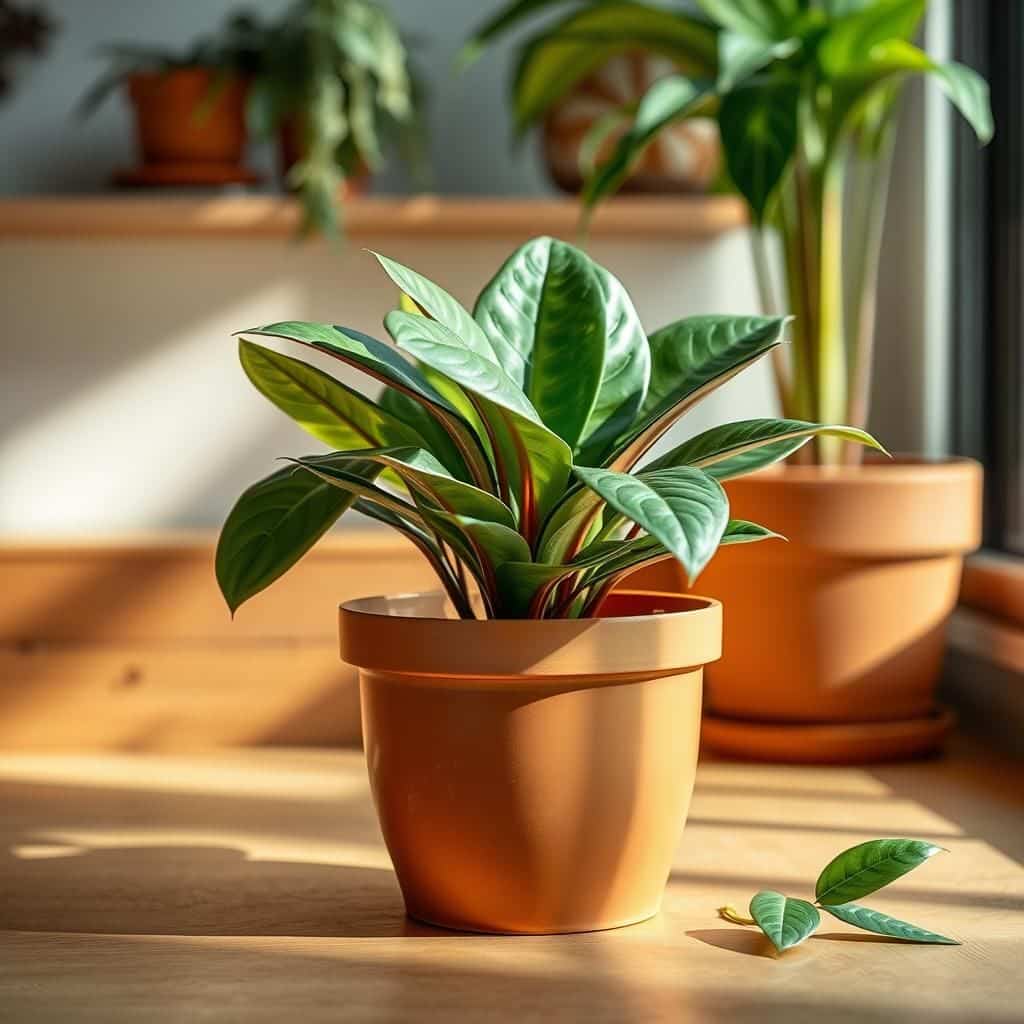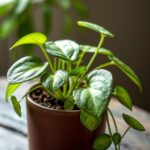Rubber Plant Indoor or Outdoor: Choosing the Best Environment for Your Plant

When it comes to cultivating a rubber plant (Ficus elastica), one of the most critical decisions a plant owner faces is selecting the ideal environment for its growth. These lush, green beauties can thrive both indoors and outdoors, but each setting offers distinct advantages and challenges. Understanding the specific needs of a rubber plant—such as light, temperature, and humidity—will help you create a nurturing space that promotes robust growth and stunning foliage. This article will guide you through the key factors to consider, ensuring that your rubber plant flourishes in its chosen environment, whether it be the comfort of your home or the great outdoors.
Should You Grow Rubber Plants Indoors or Outdoors?
Growing rubber plants can be an appealing choice for both indoor and outdoor settings, but the decision largely depends on your specific environment and preferences. Indoors, rubber plants thrive in bright, indirect light and prefer temperatures ranging from 60 to 75 degrees Fahrenheit. With proper care, they can grow tall and lush inside your home, enhancing your indoor air quality. Conversely, outdoors, rubber plants can flourish in warmer climates with well-drained soil and partial shade, although they may struggle in colder regions. Thus, understanding your local climate and the growing conditions inside your home will play a crucial role in determining whether to cultivate your rubber plant indoors or outdoors.
Ideal Conditions for Indoor Rubber Plants
Indoor rubber plants require specific conditions to thrive, primarily bright, indirect sunlight. Placing them near a window can benefit their growth, while direct sunlight may scorch their leaves. Additionally, maintaining a consistent temperature between 60 and 75 degrees Fahrenheit is vital. Humidity levels also play a crucial role; rubber plants prefer higher humidity but can adapt to typical household levels. Regularly checking the soil moisture is important, as overwatering can lead to root rot, while underwatering can cause leaf drop.
Benefits of Growing Rubber Plants Indoors
Growing rubber plants indoors offers several distinct benefits. Firstly, they are renowned for their air-purifying qualities, as they can absorb toxins and improve overall indoor air quality. Furthermore, their lush, evergreen foliage adds a touch of nature to interior spaces, enhancing aesthetic appeal. Rubber plants are relatively low-maintenance compared to other houseplants, making them suitable for both novice and experienced gardeners. Additionally, they can adapt well to varying light conditions, providing greater versatility for indoor placement.
Outdoor Rubber Plant Growing Conditions
When grown outdoors, rubber plants flourish in a warmer climate with temperatures ideally above 50 degrees Fahrenheit. They require well-drained soil enriched with organic matter and benefit from afternoon shade to protect them from harsh sunlight. In regions where the temperature drops significantly, bringing rubber plants indoors during winter is recommended to protect them from frost damage. Outdoor rubber plants also require regular watering, especially during drier months, but care should be taken to avoid overwatering.
Challenges of Growing Rubber Plants Outdoors
There are several challenges when it comes to growing rubber plants outdoors. One significant hurdle is that they are sensitive to cold temperatures and frost, which can severely damage the plant or even kill it. Pests such as spider mites and mealybugs may also pose a risk, especially in warmer climates. Additionally, finding the right balance of sunlight can be tricky, as too much direct sun can scorch the leaves, while too little can hinder growth. Therefore, careful monitoring and management are necessary to ensure the health of rubber plants outside.
Conclusion: Which is Better for Rubber Plants?
Ultimately, the decision to grow rubber plants indoors or outdoors should be guided by your environmental conditions and personal preferences. Both options have unique benefits and challenges, and your choice will influence the aesthetic and health of your rubber plants.
| Aspect | Indoor | Outdoor |
|---|---|---|
| Light | Bright, indirect light | Partial shade |
| Temperature | 60 to 75°F | Above 50°F |
| Humidity | Higher humidity preferred | Varies with climate |
| Pests | Less exposure | Greater risk |
| Maintenance | Low maintenance | Moderate maintenance |
Can I put my rubber plant outside?

When considering placing your rubber plant (Ficus elastica) outside, several factors must be taken into account to ensure its health and growth. Rubber plants are native to tropical regions, and while they can thrive in outdoor settings under the right conditions, there are specific considerations to keep in mind.
Understanding Outdoor Conditions
Rubber plants prefer warm temperatures and humidity, which are often found in tropical climates. When placing your rubber plant outside, ensure that:
- Temperature: Rubber plants thrive best in temperatures ranging from 60°F to 80°F (16°C to 27°C).
- Humidity: High humidity levels are ideal, so consider your local humidity when moving your plant.
- Sunlight: Choose a location with indirect light; direct sunlight can scorch the leaves.
Choosing the Right Location
The location of your rubber plant is crucial for its acclimatization and overall health. Here’s what to consider:
- Shade: Place the plant in a spot that receives filtered sunlight or partial shade to prevent leaf burn.
- Wind Protection: Avoid areas with strong winds that may damage the plant or dry it out.
- Accessibility: Ensure the location allows for easy access to water and care while keeping in mind the plant’s size.
Timing the Move Outdoors
Timing is essential when transitioning your rubber plant outdoors. Consider the following:
- Spring Transition: The best time to move your rubber plant outside is during warm spring months when temperatures consistently remain above 60°F (16°C).
- Acclimatization: Gradually introduce your rubber plant to outdoor conditions by placing it outside for a few hours each day for a week.
- Monitor Weather: Be vigilant about sudden changes in weather, especially cold snaps that can affect your plant.
Care Requirements When Outdoors
Caring for a rubber plant outdoors involves adjustments in its usual care routine:
See also:
- Watering: Check the soil moisture regularly; outdoor conditions may require more frequent watering compared to indoors.
- Pest Control: Keep an eye out for pests like aphids or spider mites, which may be more prevalent outdoors.
- Fertilization: Consider fertilizing your rubber plant during the growing season to boost its growth outside.
Bringing Your Rubber Plant Indoors
If conditions change or if you need to bring your rubber plant back indoors, follow these guidelines:
- Timing: Bring the plant back inside before the first frost or when temperatures drop below 60°F (16°C).
- Inspection: Check for pests and diseases before moving it back indoors to prevent infestations in your indoor plants.
- Adjustment Period: Similar to its outdoor transition, give the plant time to adjust to indoor conditions gradually.
Does a rubber plant need sunlight?

Yes, a rubber plant (Ficus elastica) does need sunlight to thrive. It is a tropical tree that originates from Southeast Asia, where it can grow under the dappled light of larger trees. While rubber plants can tolerate low light conditions, providing them with the right amount of sunlight is essential for optimal growth and health.
Understanding Light Requirements
Rubber plants prefer bright, indirect sunlight but can adapt to lower light conditions. However, insufficient light can lead to slow growth and a loss of leaves. Here are key points regarding their light needs:
- Bright, Indirect Light: Ideal for promoting lush foliage.
- Low Light Tolerance: Can survive in lower light but may lose vigor.
- Avoid Direct Sunlight: Too much direct sun can scorch their leaves.
How to Position Your Rubber Plant
Proper placement of your rubber plant is crucial to meet its light requirements. Follow these tips to ensure that it receives the right amount of light:
- Near a Window: Position your plant close to east or west-facing windows.
- Avoid North Windows: These often do not provide enough light.
- Rotate the Plant: Regularly turn the plant to promote even growth on all sides.
Signs of Too Much or Too Little Light
Monitoring your rubber plant for signs of light stress is essential for its health. Here are some indicators to look for:
- Leaf Yellowing: Can indicate too much direct sunlight or insufficient light.
- Stunted Growth: Slow growth can suggest inadequate light conditions.
- Leaf Drop: Losing leaves may occur if placed in too low light.
Adjusting Light Conditions
If you notice issues with your rubber plant, adjusting its exposure can help remedy the situation. Consider these options to improve light conditions:
- Move the Plant: Relocate it to a brighter area, but avoid direct sunlight.
- Use Sheer Curtains: If placed in bright light, curtains can filter the sun.
- Supplement with Grow Lights: Use artificial lights if natural light is limited.
Seasonal Considerations
The amount and quality of sunlight can change with the seasons, affecting your rubber plant. Keep these seasonal tips in mind:
- Winter Adjustments: Move closer to the light source during shorter days.
- Spring Growth: Increased light encourages new growth as days lengthen.
- Summer Care: Monitor for signs of stress due to increased sunlight.
What temperature can rubber plants tolerate?

Rubber plants, scientifically known as Ficus elastica, are popular houseplants due to their attractive foliage and adaptability. When it comes to temperature tolerance, rubber plants are quite resilient but have specific ranges that they prefer for optimal growth.
The ideal temperature range for rubber plants is between 60°F to 75°F (15°C to 24°C). They can tolerate slightly lower temperatures down to 50°F (10°C) but prolonged exposure to cold conditions can be harmful. On the other end, rubber plants can manage temperatures as high as 85°F (29°C), but they may suffer in excessively hot conditions, especially if humidity is low. It’s essential to maintain a stable environment without sudden drafts or temperature fluctuations, as these can stress the plant.
Temperature Preferences of Rubber Plants
Rubber plants thrive best in moderate temperatures, typically around 70°F (21°C) during the day. They can tolerate a bit of variation but prefer a stable environment.
- Daytime temperatures are best between 70°F to 75°F.
- Nighttime temperatures should ideally be around 60°F to 65°F.
- Avoid temperatures below 50°F to prevent damage to the plant.
Effects of Cold Temperatures
When exposed to cold temperatures, rubber plants can experience a range of issues, including leaf drop, stunted growth, and potential death of the plant if conditions are severe.
See also:
- Leaves may start to yellow and fall off.
- Growth will slow down significantly.
- Extended exposure can lead to plant death, especially below 40°F (4°C).
Effects of High Temperatures
While rubber plants can tolerate high temperatures, excessive heat can lead to dehydration and leaf burn if the humidity levels are not adequate.
- Higher temperatures can result in wilting leaves.
- Too much heat can cause leaf tips to brown and curl.
- Ensure consistent humidity to prevent stress in hot conditions.
Seasonal Temperature Considerations
Rubber plants can adapt to seasonal changes, but it is crucial to monitor their living conditions to prevent temperature shocks during seasonal transitions.
- During summer, maintain humidity levels to combat high heat.
- In winter, keep them away from drafty windows and heating vents.
- Consistent indoor temperatures are key during seasonal shifts.
Indoor vs Outdoor Temperature Tolerance
Rubber plants are predominantly grown indoors as houseplants, where temperature control is more manageable, but with adequate precautions, they can also thrive outdoors in suitable climates.
- Outdoors, they thrive in USDA hardiness zones 10-12.
- Always provide a shaded area if temperatures exceed 85°F.
- Indoor plants benefit from regulated temperatures and protection from drafts.
Can rubber plants go in full sun?

Rubber plants, scientifically known as Ficus elastica, are popular houseplants valued for their lush, glossy leaves and air-purifying qualities. When it comes to their lighting needs, full sun exposure can be a concern for many plant owners. While rubber plants thrive in bright, indirect light, placing them in full sun can lead to problems.
Understanding Full Sun Conditions
Full sun typically refers to a location that receives at least 6 hours of direct sunlight each day. This intense light can be too much for rubber plants, which are adapted to lower light conditions in their natural habitat. Prolonged exposure to full sun can result in numerous stress signs in rubber plants.
- Leaf Burn: Leaves may develop brown spots or crispy edges.
- Faded Colors: The vibrant green may diminish, resulting in a dull appearance.
- Growth Issues: The plant's overall health could decline, stunting growth.
Signs Your Rubber Plant Is Overexposed
If your rubber plant is placed in full sun, you'll notice some clear symptoms of distress. These signs can guide you in adjusting the plant’s location to ensure its health.
- Leaf Drop: A significant loss of leaves can occur as the plant struggles.
- Wilting: Leaves may begin to droop, indicating water stress.
- Discoloration: Yellowing leaves are often a sign of poor light conditions.
Best Lighting Conditions for Rubber Plants
Rubber plants perform best in bright, indirect light. This means they can benefit from abundant light without being scorched by direct sun rays.
- Filtered Light: Place them near a window with sheer curtains.
- East or West Exposure: These positions offer balanced light without harsh intensity.
- Rotating Plants: Regularly turn the plant for even light exposure.
How to Adjust Light for Your Rubber Plant
If your rubber plant shows signs of distress from too much sunlight, it’s essential to reposition it promptly. Here's how to effectively adjust its lighting situation.
- Move Indoors: If outside, bring the plant indoors to a lighter location.
- Change Window: Relocate to a window that offers filtered light.
- Use Grow Lights: Consider supplemental lighting if natural light is insufficient.
How to Care for Rubber Plants in Changeable Lighting
After correcting your rubber plant's lighting conditions, it's important to provide ongoing care to help it recover and flourish.
- Monitor Watering: Adjust your watering routine since light levels affect moisture needs.
- Nutrient Boost: Offer a balanced fertilizer during the growing season.
- Prune Damaged Leaves: Trim any unsightly foliage to promote new growth.
Questions from Our Readers
Is a rubber plant better suited for indoor or outdoor conditions?
A rubber plant is primarily considered an indoor plant, as it thrives in controlled environments with consistent temperatures and humidity. While it can be placed outdoors in warmer climates, it is essential to ensure it is shielded from direct sunlight and extreme weather conditions, which can harm the plant.
What are the benefits of keeping a rubber plant indoors?
Keeping a rubber plant indoors provides several advantages, such as improving air quality by filtering toxins and releasing oxygen. Additionally, its striking foliage can enhance the aesthetic of your living space, creating a more vibrant and inviting atmosphere.
Can a rubber plant survive outdoors year-round?
While a rubber plant can be grown outdoors in suitable climates, it is not ideal for year-round survival in most regions, as it is sensitive to cold temperatures. In areas where temperatures drop below 15°C (60°F), it's best to bring the plant indoors during the colder months to prevent damage.
See also:
How often should I water a rubber plant when indoors versus outdoors?
When grown indoors, a rubber plant typically requires less frequent watering compared to outdoor conditions. Watering should occur when the top inch of soil feels dry, usually every 1-2 weeks, while outdoor plants may need more frequent watering due to evaporation and direct sunlight exposure.

If you want to read more articles like Rubber Plant Indoor or Outdoor: Choosing the Best Environment for Your Plant, we recommend you check out our Planter category.
Leave a Reply
Related Articles